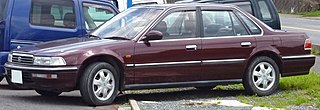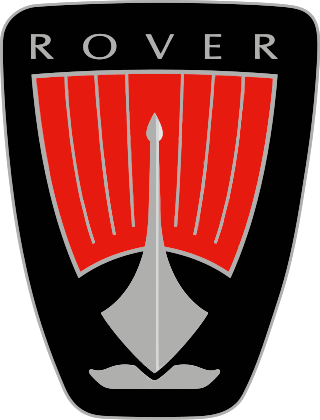
The Rover Group plc was the British vehicle manufacturing conglomerate known as "BL plc" until 1986, which had been a state-owned company since 1975. It initially included the Austin Rover Group car business, Land Rover Group, Freight Rover vans and Leyland Trucks. The Rover Group also owned the dormant trademarks from the many companies that had merged into British Leyland and its predecessors such as Triumph, Morris, Wolseley, Riley and Alvis.

The Honda Accord, also known as the Honda Inspire in Japan and China for certain generations, is a series of automobiles manufactured by Honda since 1976, best known for its four-door sedan variant, which has been one of the best-selling cars in the United States since 1989. The Accord nameplate has been applied to a variety of vehicles worldwide, including coupes, station wagons, hatchbacks and a Honda Crosstour crossover.

The Metro is a supermini car, later a city car that was produced by British Leyland (BL) and, later, the Rover Group from 1980 to 1998. It was launched in 1980 as the Austin mini Metro. It was intended to complement and eventually replace the Mini, and was developed under the codename LC8. The Metro was named by What Car? magazine as 'Car of The Year' in 1983 as an MG, and again as the Rover Metro in 1991.

The Ford Orion is a small family car that was produced by Ford Europe from 1983 until 1993. A total of 3,534,239 units were sold during the car's ten-year production life.

The Rover 800 series is an executive car range manufactured by the Austin Rover Group subsidiary of British Leyland, and its successor the Rover Group from 1986 to 1999. It was also marketed as the Sterling in the United States. Co-developed with Honda, it was a close relative to the Honda Legend and the successor to the decade-old Rover SD1.
The Austin Rover Group was a British motor manufacturer. It was created in 1982 as the mass-market car manufacturing subsidiary of British Leyland (BL). Previously, this entity had been known as BL Cars Ltd which encompassed the Austin-Morris and Jaguar-Rover-Triumph divisions of British Leyland. After a major restructuring of BL's car manufacturing operations, Jaguar regained its independence whilst the Triumph and Morris marques were retired. The new, leaner car business was rechristened as the Austin Rover Group and focused primarily on the Austin and Rover marques. The Morris and Triumph marques continued briefly within ARG until 1984 when both were dropped.

The Austin Montego is a British family car that was produced by British Leyland from 1984 until 1988, and then by Rover Group from 1988 until 1995. The Montego was the replacement for both the rear-wheel drive Morris Ital and the front-wheel drive Austin Ambassador ranges to give British Leyland an all-new competitor for the Ford Sierra and Vauxhall Cavalier.

The Rover 200 Series, and later the Rover 25, are a series of small family cars that were produced by British manufacturer Rover from 1984 until 2005.

The Honda Ascot is a compact sedan manufactured by Honda and marketed only in Japan from 1989 until 1997. The first generation produced two versions based on the Honda Accord CB series called the Ascot and from 1993 to 1996 a "pillared hardtop" called the Ascot Innova. The Innova shared much of its mechanicals with the European-market Accord manufactured at the Honda UK facility in Swindon, England, and was essentially the badge engineered Rover 600. The second generation was a platform improvement, shared with the Japan-only sedan called the Honda Rafaga. The "Ascot" name was chosen with reference to the Ascot Racecourse and Ascot tie, in order to add the model an alleged air of class and elegance. Honda Ascot was also used on a range of one-cylinder motorcycles in the first half of the 1980s.

The Rover 400 Series, and later the Rover 45, are a series of small family cars that were produced by the British manufacturer Rover from 1990 to 2005. The cars were co-developed as part of Rover's collaboration with Honda. The first-generation 400 was based on the Honda Concerto, and the Mark II 400 was based on the Honda Domani/Civic.

The Honda Ballade is a subcompact automobile built by Honda of Japan. It began as a four-door higher equipment content version of the Civic in 1980. The Ballade was developed at the same time the Honda Vigor appeared, which was a higher content Honda Accord. In Japan, the Ballade was sold exclusively at Honda Verno dealerships alongside the Vigor, Prelude, CR-X, and Quint. In the UK it was launched at the same time as the very similar Triumph Acclaim with which it shared a Honda-built engine.

The Toyota Kijang is a series of pickup trucks, multi purpose vehicles and light commercial vehicles produced and marketed mainly in Southeast Asia, Taiwan and India by Toyota between 1976 and 2007 under various other names.

The Rover 200 Coupé is a two-door coupé that was produced by Rover and based on the Rover 200 Mark II, with most of the body panels and the bumpers unique in the range. The car was launched on 6 October 1992, at the Paris Motor Show. It was given the project code name 'Tomcat' when in development.
1991 in motoring includes developments in the automotive industry that occurred throughout the year 1991 by various automobile manufacturers, grouped by country. The automotive industry designs, develops, manufactures, markets, and sells motor vehicles.
1992 in motoring includes developments in the automotive industry that occurred throughout the year 1992 by various automobile manufacturers, grouped by country. The automotive industry designs, develops, manufactures, markets, and sells motor vehicles.

The sixth-generation Honda Civic is an automobile produced by Honda from 1995 until 2000. It was introduced in 1995 with 3-door hatchback, 4-door sedan and 2-door coupe body styles, replicating its predecessor's lineup. The sixth-generation Civic offered two new 1.6-liter 4-cylinder engines and a new continuously variable transmission (CVT) on the HX model. The coupe and sedan are 2.3 in (58 mm) longer and the hatchback is 4.3 in (109 mm) longer than the previous-generation Civic. This was the last generation of Civic to have front double-wishbone suspension, as the succeeding seventh generation would change the front suspension to a MacPherson strut.

The Honda Vigor is a premium sedan that was derived from the Honda Accord. It was sold in Japan through the Honda Verno dealer network from 1981 until 1995, and sold in North America from June 1991 until 1994 as the Acura Vigor. Early Vigors were more upmarket versions of the Accord, and served as Honda's flagship until the arrival of the Honda Legend. In 1989, the Vigor would differentiate itself further from the Accord with unique styling and an available longitudinal five-cylinder engine, and a twin to the Vigor was introduced with the Honda Inspire, available at Honda Clio dealerships.

The Rover R8 platform was an automobile platform used for the Mark I Rover 200 Series and the Mark II 200 and 400 Series, compact family cars produced by the Austin Rover Group, and later the Rover Group.

Rover is a British automotive marque that was used for over a century, from 1904 to 2005. It was launched as a bicycle maker called Rover Company in 1878, before starting to manufacture autocars in 1904. The brand used the iconic Viking longship as its logo. The rights to the marque are currently part of Jaguar Land Rover, which continues to produce Land Rovers, but no Rover automobiles are currently in production and the marque is considered dormant.
The sixth-generation Honda Accord was available as a four-door sedan, a two-door coupe, five-door hatch and station wagon and was produced by Honda from September 1997 until 2002 and from 1998 to 2003 in Europe.





















